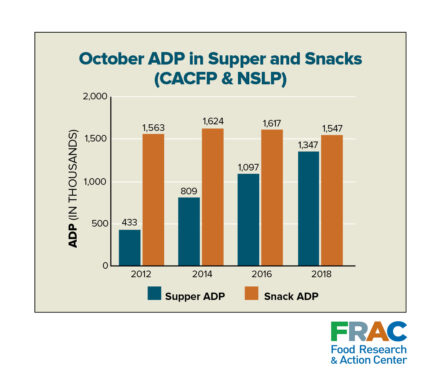Media Contact:
Emily Pickren
epickren@frac.org
202-640-1118
 WASHINGTON, October 23, 2019 — More than 1.3 million children benefited from afterschool suppers at school- and community-based programs on an average weekday in October 2018. That was a 10.4 percent increase from the previous year, according to the annual Afterschool Suppers: A Snapshot of Participation report, released today by the Food Research & Action Center (FRAC). The report finds that one child received an afterschool supper for every 16 low-income children who participated in the National School Lunch Program in October 2018.
WASHINGTON, October 23, 2019 — More than 1.3 million children benefited from afterschool suppers at school- and community-based programs on an average weekday in October 2018. That was a 10.4 percent increase from the previous year, according to the annual Afterschool Suppers: A Snapshot of Participation report, released today by the Food Research & Action Center (FRAC). The report finds that one child received an afterschool supper for every 16 low-income children who participated in the National School Lunch Program in October 2018.
“We know that poor nutrition can lead to poor academic and health outcomes for children. The federally funded Afterschool Supper Program reduces hunger and draws children into enrichment programs that keep them active and engaged,” said Jim Weill, president of FRAC. “While the increase in participation is encouraging, much more can be done to ensure low-income children who rely on school lunch also can access afterschool supper.”
Although every state has room to increase afterschool meals participation in the 2019–2020 school year and beyond, some states saw relatively high participation in afterschool suppers in October 2018. The District of Columbia exceeded FRAC’s goal for states to serve supper to at least 15 children for every 100 who received free or reduced-price school lunch, providing 22 low-income children with an afterschool supper for every 100 who received school lunch. Two additional states came close to reaching this goal: California (14 to 100) and Vermont (11 to 100). Four states — Kansas, Maine, Mississippi, and North Dakota — increased the number of children participating in supper by more than 50 percent in October 2018 compared to October 2017.
Child Nutrition Reauthorization, currently being considered by Congress, provides an opportunity to streamline eligibility requirements to allow more children to receive afterschool meals. This, combined with more private and public funding for afterschool programs — including more investment of federal, state, and local dollars — would allow sponsors to reach more children with afterschool suppers.
“The combination of afterschool programs and suppers is a win-win,” said Jodi Grant, executive director of the Afterschool Alliance. “Healthy afterschool suppers ensure that children get the nutrition they need to participate in programs that offer them the opportunity to discover new skills and learn and experience new things, such as science, poetry, and community service.” The Afterschool Alliance will celebrate afterschool programs on October 24 with its annual national Lights On Afterschool.
###
The Food Research & Action Center is the leading national nonprofit organization working to eradicate poverty-related hunger and undernutrition in the United States.

